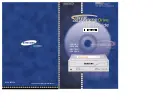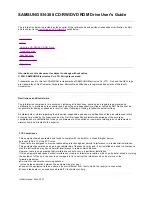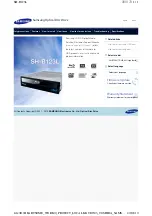
ROWAN ELETTRONICA S.R.L. - Via Ugo Foscolo, 20 - 36030 CALDOGNO (VICENZA) ITALY
8
BRAKE CONNECTION
On request, ROWAN motors can be provided with electromagnetic brake. In this case the motor must be constructed
expressly with lengthened motor shaft and the brake is mounted on the front part, supported by a bell which reproduces
the normal flanging conditions.
There are 2 different types of brakes:
- DIRECT BRAKE: in this case it is necessary to supply the brake to block the motor shaft. This kind of brake is suitable
for precision stops.
- SAFETY SPRING BRAKE: in this case it is necessary to remove supply from the brake to block the motor shaft. It is used
as safety brake in case of lack of main power supply, with suspended loads as overhead travelling cranes, cranes etc.
Both brakes operate with direct voltage 24VDC, for an operating cycle S6 with max 5 'of excitation and 5' of de-excitation
and are supplied through the single terminal or connector placed on the front brake bearing-bell.
For an optimized management of the brake, ROWAN suggests the card code 321S, to be connected as shown below:
The C321S provides a peak of max 34VDC and a subsequent holding voltage of 24VDC. This speeds up the release of
the BRAKE and prevents overheating during continuous service for prolonged periods. For repeated excitations, wait at
least 1 second between de-excitation and re-excitation of the brake.
INSTRUCTIONS FOR CONNECTION and START-UP
Before powering, connect to the ground and set up the microswitches on the board to suit the desired type of operation:
- 2 or 3 wire speed regulation potentiometer
- inclusion of internal/external torque limitation
(see microswitch description)
- 2, 4 or 6-pole motor
In case of a 6-pole single-phase motor recalibrate the maximum speed with trimmer P4 until the tachometer dynamo
generates approx. 5.7 VDC with the speed regulation potentiometer or DC signal at maximum value.
- Before powering, adjust the potentiometer or DC signal for zero speed; at power up the motor must be stationary.
Illumination of led L1 (power on) indicates that power supply is flowing through the driving circuits. Turn potentiometer or
increase DC signal: motor speed should increase or decrease according to the set acceleration/deceleration ramp, while
leds L2 (run) and L3 (tachometer gen. presence) must light up accordingly; progressive illumination of led L2 indicates
the presence of voltage in the motor windings, whereas light-up of L3 indicates that the motor is rotating.
- If the motor suddenly races to maximum speed without following potentiometer regulation, and pilot lamp L3 does not
illuminate, it means that tachometer dynamo voltage is not reaching terminals 7 and 8; when this happens, check the
connections again.
- Check attainment of maximum speed and, if necessary, fine adjust the maximum value with trimmer P4; be sure not to
exceed the maximum speed as this would cause the motor to overheat even when loadless; when this happens regulate
P4 until motor consumption equals the value measured at an intermediate speed. In any case check that motor
consumption (measured at power supply line) conforms with the rated value. If during motor operation oscillations take
place due to a particular type of load or due to mechanical transmission, these may be suppressed by regulating trimmer
P7 clockwise; if regulation of P7 were not enough, also regulate trimmer P6 counter-clockwise. To prompt and smoothen
motor response you may close microswitch S5.
Drive 119/92 is provided with a 0,5A protection fuse only for driving circuit; provide external power protection through a
10A fuse for drive 119/92 and 20A fuse for drive 119/92-2HP. Use a shielded cable for control connections (potentiometer,
tachometer generator) especially if they are long stretches or run close to power cables; connect cable braiding to ground
and not to the circuit negative, and only at one cable terminal; the board negative must also not be connected to ground;
at any rate, do your best to avoid routing near power cables or large transformers.
Use relays with contacts for low current for the switching of DC signals on the control terminal panel, and avoid the use
of electromagnetic switch auxiliary contacts for these types of operations.
Drives 119/92 operate efficiently with panel temperatures ranging from -5°C to +40°C; temperatures outside this range
may give rise to faulty operation, speed control drifts and, if temperatures are particularly high, breakdown. Thus place the
boards far from heat sources and provide adequate ventilation to the panel if the environment is subject to high
temperatures.
ISTRUCTIONS FOR THE CORRECT INSTALLATIONS AS PER THE ELECTRO-MAGNETIC COMPATIBILITY
STANDARDS (E.M.C.)
Drive Code 119/92 must be powered on through anti E.M.I. filter as indicated in the connection diagrams on page 11; if
more C119/92 drives are installed into the same cabinet we can use a unique filter dimensioned for the total supply
currents. In addition, it is necessary to use a shielded cable to connect the commands (potentiometer, tachometer)
especially when distances are long and we are near to power cables; the cable sleeve must be connected to ground (not
to the negative of the circuit) to one end only; do not connect the negative of the drive to ground; avoid, in any case, the
proximity to power cables or big transformers. Avoid, finally, to create ground loops.
C321S
BRAKE
T V
400
230
0
0
24
BRAKE
command
(3A)


































